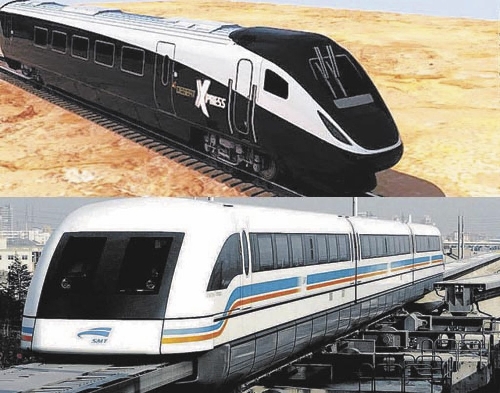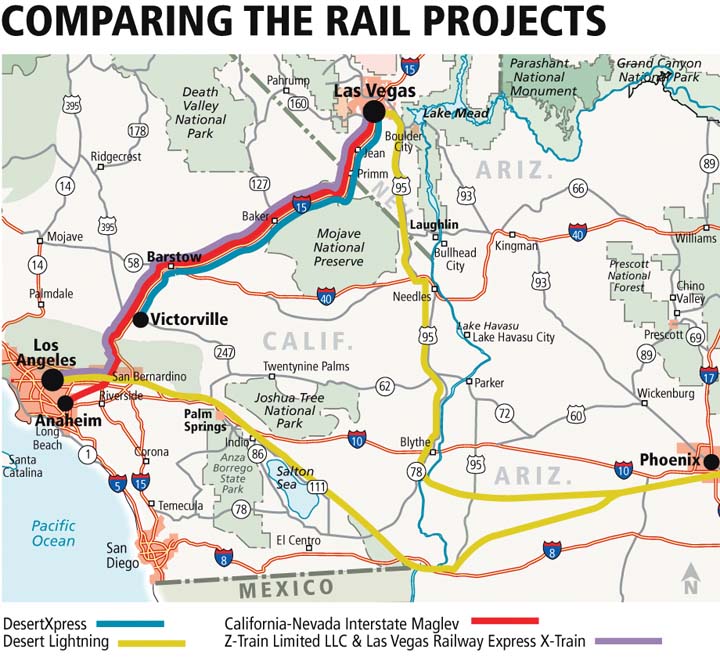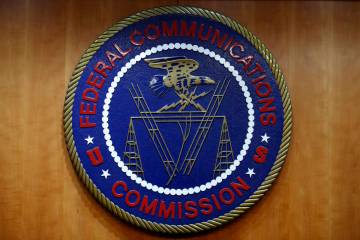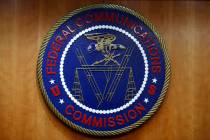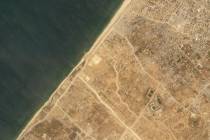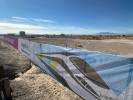Comparing, contrasting Southern Nevada train proposals
The many Las Vegas-to-Los Angeles train proposals raise questions about whether any can gain the financial traction to succeed or whether they will simply steal each other's steam.
Transportation experts claim that funding for high-speed rail nationwide might be spread too thin for any project to be completed.
Where does that leave Southern Nevada?
Two traditional locomotive companies have announced plans to begin service. But the proposed high-speed lines have garnered the most attention locally and nationally.
Two high-speed rail companies say they are ready to roll soon, but they already are crashing into each other in a fight for the same limited funding. Details are vague on a recent third proposal.
They present an interesting debate: magnetic levitation rail vs. steel-wheeled line.
If Las Vegas is serious about landing a bullet train, that controversy should end now, said Anthony Perl, a fellow with the Post Carbon Institute, a California-based think tank that aids communities adapting to dwindling resources, such as oil.
"They're not going to do anything other than hold back progress by holding these types of debates," said Perl, who has studied high-speed rail proposals and systems for 25 years.
Perl can't envision these two trains vying for the same money source because he believes the magnetic levitation project is a fantasy.
"They're the unicorn of the transportation world," Perl said. "People are always imagining seeing them in the mist, but as you approach them they fade away."
Perl did offer a caveat for Maglev fans: "Las Vegas is a place where all sorts of imagination is encouraged. It (the Maglev) is certainly no more fantastic than some of the things on the Strip."
Even as new projects enter the race to build a passenger rail system between Southern Nevada and Southern California, the two major competitors continued to blast each other.
Folks behind the Maglev call the steel-wheeled ride a "train to nowhere," and the DesertXpress electric train backers call the magnetic system an overpriced pipe dream.
Still, both claim they are powering ahead.
As of this summer, backers of three high-speed rail projects -- DesertXpress, the California-Nevada Interstate Maglev and the Desert Lightning -- have vowed to provide service between Las Vegas and Los Angeles within the next few years.
Two traditional train companies -- Z-Train Limited LLC and Las Vegas Railway Express -- recently introduced their own proposals. That brings the official count to five.
Two high-speed rivals have been at the forefront of the rail battle. California-Nevada Interstate Maglev and DesertXpress attack each other's plans, even claiming the other's technology already is outdated.
Most Las Vegans appear to get more excited about a magnetic-powered bullet train that will tear through the desert at 300 mph and arrive in Anaheim, Calif., in 81 minutes.
But the Maglev stalled last summer when Senate Majority Leader Harry Reid, D-Nev., switched allegiances to the DesertXpress, eventually toting $45 million in federal funding with him.
Reid said his about-face came after he witnessed no progress despite Maglev representatives talking about the line for three decades. But, according to an expert in tune with the politics swirling around high-speed rail, Reid may have sensed his colleagues on Capitol Hill would never take an Anaheim to Las Vegas rail seriously enough to fund it.
In pointing out wasteful spending by the federal government, Louisiana Gov. Bobby Jindal, a Republican, slammed Democrats last year for funding various projects including "$8 billion for high speed-rail projects, such as a 'magnetic levitation' line from Las Vegas to Disneyland."
Yorah Freemark, a writer for the magazine The Transport Politic, said Jindal's comment struck a nerve.
"This has made the administration sensitive to charges that the high-speed rail program is a plaything, not a serious transportation tool," Freemark said. "Too much focus on a Las Vegas project could be politically problematic."
Politics already has played a role in the push-pull over the two trains. Outgoing Gov. Jim Gibbons, a Republican, jumped on the train-to-nowhere argument and bashed Reid for supporting it. Reid, on the other hand, questioned Gibbons for supporting pricey and unproven technology.
The political barking isn't unique to Nevada, said Perl, an outsider who won't benefit from the outcome unlike many local transportation experts or politicians who already have backed a specific proposal.
"Huge amounts of money are going to be made or lost, depending on what happens," Perl said. "It takes political will and commitment to do these things."
Perhaps it is safer logically, and politically, to support a train that is ultimately expected to link Las Vegas, not only to Disneyland, but with a network of lines that reach San Diego, San Francisco and Sacramento, Perl said. One of many disadvantages attached to maglev technology is that it cannot be tied into existing urban rail networks or their rights of way, he said.
Perl also notes that only one maglev system exists -- a demonstration line in Shanghai, China -- and that using the technology as a reliable mode of commuter transportation is untested. It also uses massive amounts of energy and is far more costly than steel-wheel technology.
Perl also said any suggestion that a maglev train will sail through metropolitan areas is misleading.
"These things run at a speed that would suck the windows out of buildings a half a block from the tracks. You can't have anyone living near it," Perl said. "It has to stop at the edge of California. By definition, it has to start in a place where people cannot get to quickly and easily unless you are prepared to tunnel, which triples the cost."
That leads to the debate over destinations.
Opponents of the DesertXpress scoff at the Victorville destination, a point chosen in large part because of the high-speed steel-wheeled technology's inability to negotiate steep grades in the Cajon Pass which links the high desert to the Los Angeles basin.
Who would ride the train from Las Vegas to the high desert, only to rent a vehicle and drive the most congested segment of the commute to Southern California?
"When we zero in on the Inland Empire and the high desert, that's where the population growth is occurring," Tom Stone, president of the DesertXpress, said in defense of the Victorville hub. "That's where the growth revenues will be coming the next 20 years."
Stone said the ridership study performed for his company by the URS Corporation, an engineering design firm, also showed that residents who live near airports fly more frequently. Inland Empire residents have no airport nearby.
Maglev adversaries claim the fact that the Maglev train would initially run 40 miles between Primm and Las Vegas often is lost in the debate. If it is ever built, experts said, that line could very well end up as the valley's own demonstration ride similar to that in Shanghai.
Perl and Freemark agree that it could be a problem if Victorville turns out to be the terminus for the DesertXpress and it doesn't hook up to a proposed California high-speed rail system. Representatives of the steel-wheeled project are confident it will quickly hook up to Palmdale, Calif., where passengers can transfer to trains heading north or south.
"It's a stopgap way to get things started," Perl said.
The federal government will not allow the lighter, faster trains to use existing lines, most of which accommodate heavy freights. Because the trains cannot share tracks with traditional trains, "the trains may be stuck in Victorville for several years, which obviously poses some major problems," Freemark said.
"On the other hand," Freemark quickly added, "if the project were extended to Palmdale, for instance, the opportunity for direct connections to the California High-Speed project is phenomenal. It's this interface that ultimately makes DesertXpress by far the most appropriate project for this corridor."
Maglev representatives also attempt to discredit the DesertXpress by saying its representatives vowed to break ground in April when the chances are they won't begin construction this year.
DesertXpress points to its competitor's sputtering progress.
Historically, high-speed rail projects haven't rolled out overnight.
California lawmakers have discussed the possibility of high-speed rail since the early 1980s. Florida has been talking about an Orlando-to-Tampa high-speed rail line since 1976, even at one point passing a law requiring that a bullet train be built.
After decades of discussions and formations of commissions and focus groups, nothing has happened. The lack of progress didn't keep President Barack Obama's administration from deeming Florida and California fit for stimulus money to fund high-speed rail systems.
"I can see both of them in some form of operation in the next decade," Perl said. "There will be a stampede effect, assuming the U.S. economy is capable of supporting that. People will wonder why we didn't do this 25 years sooner."
But the prospects of federal funding for a high-speed passenger line linking Las Vegas to California are iffy, Freemark said.
"Congress has yet to demonstrate a serious, long-lasting commitment to high-speed rail and, even when it does, there's not reason to think that the Las Vegas corridor will be prioritized," he said. "This doesn't mean there's no chance that anything will be built; it just means that more money is necessary."
Perl noted that Nevada has an advantage over other states. The bulk of the route runs through desert land, not populated urban areas. And Nevada is capable of generating electricity to power the DesertXpress through the use of solar technology.
Funding remains a serious obstacle.
According to a U.S. Department of Transportation study performed in 1990, the average overrun costs related to rail projects is about 50 percent. Seven of 10 major rail lines studied in the United States had exceeded the original budget by 30 percent to 100 percent.
If that is the case, both projected price tags -- DesertXpress' $4 billion and Interstate Maglev's $12 billion -- could be expected to balloon.
California can attest to this pattern. In 2008, voters approved a $9 billion bond to help fund the 700-mile route between San Francisco and Los Angeles, a project expected to cost $33.6 billion. According to Stanford University's Hoover Institute, the price tag has grown to $42.6 billion.
California might not have the funds to build its high-speed rail network at all.
The Hoover Institute report says the rail authority's "latest business plan contains no realistic outline of how California will pay to build a high-speed rail system."
"And so the ridership problems, political problems, route problems and timeline problems all become secondary -- none of them matters if billions of construction dollars never materialize."
Kent Dagnall, a representative for the California-Nevada Interstate Maglev, said Chinese investors remain interested in loaning the high-speed project $7 billion if the U.S. government is willing to pay it back should the train fail. Dagnall holds hope the government will oblige, but said Reid's "misrepresentations" of the Maglev's progress isn't helping matters.
"It's unfair to say that we haven't done anything in 30 years," Dagnall said, noting that the California-Nevada Interstate Maglev Project was formed in 1997.
"The truth of the matter is there was no will whatsoever for transportation projects under the last administration. Only since the last president has been in power has there been any will for a transportation project."
Perl emphasized the need to move forward because if oil prices continue to rise, the future of auto and air travel -- both vital to tourism and the economy in Las Vegas -- looks bleak. Electric cars are not the answer, he said, as most families will not be able to afford one.
"The energy picture is less clear," Perl said. "It's important to make a decision and start doing something. You can't spend the next two years debating between the maglev and the high-speed train. We're past the point where we have a lot of time left for these discussions."
So what about the other train proposals?
■ A group of investors from the East Coast, Genesis High Speed Rail America LLC, recently entered the race with the Desert Lightning, a high-speed rail linking Las Vegas, Los Angeles and Phoenix. The company's announcement was vague and didn't reveal its funding strategy, although it estimated the project would cost between $35 billion and $40 billion.
■ The Las Vegas Railway Express' X-train unveiled plans to start a "party line" -- complete with a rolling sports bar and entertainment -- between Las Vegas and Los Angeles that would make its inaugural run by mid-2011. The trip would take about 5½ hours each way.
■ Then Z-Train Limited announced plans for a privately funded line between Los Angeles and Las Vegas that could begin service by winter 2011. The Z-Train claims the X-train proponents ripped off their idea. Both companies indicated they planned to use the existing Union Pacific railroad tracks.
Last month, both the X-train and Z-Train appeared to be derailed by a letter from Union Pacific officials.
"Despite the representations ... there are no pending agreements or negotiations with Union Pacific that could result in any agreement to operate on UP rights of way," wrote Jerry Wilmoth, general manager of Union Pacific's network infrastructure. "UP is requesting that you remedy these misperceptions."
Neither representatives of Maglev nor DesertXpress seemed concerned about the plans recently introduced. Each realizes the process to build a rail line is both lengthy and expensive.
The companies recently joining the rail arena haven't produced financial strategies, the first step.
Freemark also dismissed the possibility that a traditional train could be successful at this point.
"There's nothing 'wrong' with bringing back diesel, traditional Amtrak service," he said. "But expecting it to bring crowds, or even cover operating costs, seems like a stretch."
The main event in the fight between trains has been between the Maglev and the DesertXpress. Perl has no qualms declaring the steel-wheeled project the winner.
"One is much more realistic than the other; that represents the professional wisdom of the transportation community," he said. "When people are serious about transportation advances, they talk about things that are real rather than imaginary."
Contact reporter Adrienne Packer at apacker@reviewjournal.com or 702-387-2904.
PDF: Train facts



